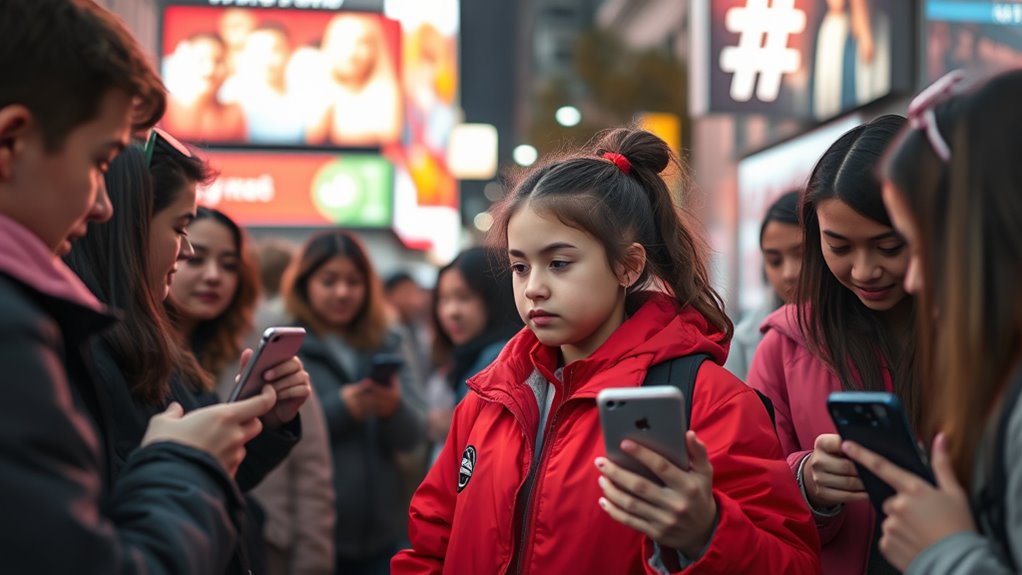Algorithmic bias in viral trends often leaves marginalized groups and niche voices behind because platforms tend to promote content that aligns with mainstream preferences. You might notice that popular posts get amplified while diverse or unconventional perspectives struggle to gain visibility. This happens because algorithms favor familiar, widely accepted content, reinforcing existing social hierarchies. If you want to understand how these biases shape online conversations and who gets left out, there’s more to uncover ahead.
Key Takeaways
- Algorithmic biases favor mainstream content, often marginalizing niche, minority, or unconventional voices in viral trends.
- Training data reflecting societal prejudices can lead to the underrepresentation of marginalized groups.
- Content from marginalized communities is often suppressed or ignored by algorithms promoting popular posts.
- Algorithmic amplification reinforces existing social hierarchies, leaving out diverse perspectives.
- Advocating for transparency and inclusivity in algorithms can help reduce bias and support marginalized voices.

In today’s digital landscape, algorithms play a essential role in shaping what content goes viral. They determine which videos, memes, or stories catch fire and reach millions of viewers. But the way these algorithms work isn’t perfect—sometimes, they introduce biases that influence what gets amplified and what gets left behind. This phenomenon, known as algorithmic bias, can skew social amplification, favoring certain voices over others. When algorithms prioritize content based on engagement metrics like likes, shares, or comments, they inadvertently create echo chambers that strengthen existing societal divides. As a result, marginalized groups or niche communities often find themselves excluded from the viral spotlight, simply because their content doesn’t fit the patterns that algorithms reward.
Understanding algorithmic bias means recognizing that these systems aren’t neutral. They are shaped by the data they’re trained on and the objectives set by developers. If the training data reflects societal prejudices or gaps, the algorithm will reproduce those biases, favoring certain demographics or viewpoints while silencing others. For instance, if a platform’s algorithm tends to promote mainstream content that appeals to the majority, minority voices or unconventional ideas might never gain the same visibility. This creates a cycle where popular content gets further boosted through social amplification, while lesser-known content remains buried. You might notice that despite your efforts to share diverse perspectives, your posts don’t reach as wide an audience as those that conform to popular trends, illustrating how algorithmic bias shapes the distribution of viral content.
Algorithms reflect societal biases, favoring mainstream content and silencing diverse voices.
Social amplification plays a essential role here. When a post begins to trend, the algorithm perceives it as engaging and pushes it to more users. This process can exponentially increase its reach, but only if the content aligns with the algorithm’s preferences. If biases exist within the system, certain types of content—often mainstream or already popular—are amplified more than others, reinforcing existing social hierarchies. Those outside the favored circles often find their content ignored or suppressed, perpetuating inequality. As a user, you might wonder why some voices consistently dominate the viral landscape while others struggle to break through. The answer lies in the complex, biased nature of these algorithms and the social amplification they create, which often favors the already popular over the marginalized.
Ultimately, recognizing the influence of algorithmic bias is essential if you want to understand who gets left out of viral trends. Algorithms aren’t just neutral tools—they shape societal conversations, often unintentionally perpetuating inequality. To foster a more inclusive digital environment, it’s vital to question how content is prioritized, advocate for transparency in algorithm design, and support diverse voices that might otherwise be drowned out by the social amplification of dominant narratives.
Frequently Asked Questions
How Does Algorithmic Bias Evolve Over Time in Viral Trend Detection?
You wonder how algorithmic bias evolves over time in viral trend detection. As algorithms learn, their evolution can lead to bias amplification, where initial biases become more pronounced. Over time, shifts in data and user behavior influence this process, sometimes reinforcing stereotypes or excluding certain groups. Recognizing this evolution helps you understand the importance of ongoing monitoring and adjusting algorithms to prevent bias from deepening and to promote fairer trend detection.
Can User Behavior Influence Algorithmic Bias in Trend Dissemination?
Your behavior plays a significant role in shaping algorithmic bias in trend dissemination. When you engage more with certain types of content, you influence the algorithm’s understanding of your preferences, which can reinforce existing biases. By actively choosing diverse content and questioning what you see, you help reduce bias, encouraging a more inclusive spread of viral trends. Your user influence can promote a broader, more equitable trend landscape.
What Role Do Social Media Platforms Play in Perpetuating Bias?
Social media platforms play a significant role in perpetuating bias by creating filter bubbles and echo chambers. You may only see content that aligns with your interests and beliefs, limiting diverse perspectives. Algorithms prioritize engaging posts, often reinforcing existing biases and excluding marginalized voices. This cycle deepens societal divides, making it harder for different groups to be heard. To challenge this, you should seek varied sources and critically evaluate the content you encounter.
Are There Existing Tools to Detect and Correct Algorithmic Bias?
Think of bias detection tools as the navigators guiding your journey through a bias-laden maze. Yes, tools exist for bias mitigation and fairness auditing, helping you identify and correct unfair algorithmic patterns. These include AI fairness checkers and bias detection algorithms that scrutinize data and model outputs. Using them, you can guarantee your platform promotes equitable visibility, making sure no voice gets lost in the digital crowd.
How Does Bias Impact Marginalized Communities Differently in Viral Trends?
You should realize that bias in viral trends often leads to digital exclusion for marginalized communities, making it harder for them to gain visibility. This bias can also cause cultural misrepresentation, skewing perceptions and silencing authentic voices. As a result, these communities may struggle to access opportunities, share their stories, or influence the narrative, further deepening inequality and reinforcing existing social divides.
Conclusion
If you ignore algorithmic bias in viral trends, you’re risking a world where only the loudest, most privileged voices dominate, leaving everyone else in complete darkness. It’s not just unfair; it’s a catastrophe waiting to happen. By turning a blind eye, you could be fueling a society where the marginalized are silenced forever, and genuine diversity is destroyed. Wake up now—because if you don’t, the future will be a barren landscape of exclusion and inequality.










